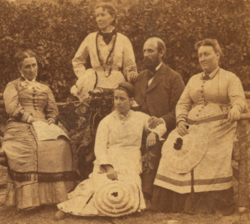This article needs additional citations for verification. (November 2007) |
| Reynolds v. United States | |
|---|---|
 | |
| Argued November 14–15, 1878 Decided January 6, 1879 | |
| Full case name | George Reynolds v. United States |
| Citations | 98 U.S. 145 (more) 25 L. Ed. 244; 1878 U.S. LEXIS 1374; 8 Otto 145 |
| Case history | |
| Prior | Defendant convicted, District Court for the 3rd Judicial District of the Territory of Utah; conviction upheld by Utah Territorial Supreme Court |
| Holding | |
| The Free Exercise Clause of the First Amendment protects the right to hold any religious belief, but not the right to engage in any religious activity whatsoever. Supreme Court of Utah affirmed. | |
| Court membership | |
| |
| Case opinions | |
| Majority | Waite, joined by Clifford, Swayne, Miller, Strong, Bradley, Hunt, Harlan |
| Concur/dissent | Field |
| Laws applied | |
| Sect. 5352 of the Revised Statutes | |
| Mormonism and polygamy |
|---|
 |
|
|
Reynolds v. United States, 98 U.S. 145 (1878), was a Supreme Court of the United States case which held that religious duty was not a defense to a criminal indictment.[1] Reynolds was the first Supreme Court opinion to address the First Amendment's protection of religious liberties, impartial juries and the Confrontation Clauses of the Sixth Amendment.
George Reynolds was a member of the Church of Jesus Christ of Latter-day Saints (LDS Church), charged with bigamy under the Morrill Anti-Bigamy Act after marrying Amelia Jane Schofield while still married to Mary Ann Tuddenham in Utah Territory. He was secretary to Brigham Young and presented himself as a test of the federal government's attempt to outlaw polygamy. An earlier conviction was overturned on technical grounds.[2]
- ^ Reynolds v. United States, 98 U.S. 145 (1878).
 This article incorporates public domain material from this U.S government document.
This article incorporates public domain material from this U.S government document.
- ^ Riggs, Robert E. (1992). "Reynolds V. United States". In Ludlow, Daniel H. (ed.). The Encyclopedia of Mormonism. New York: Macmillan. pp. 1229–1230. ISBN 0-02-879605-5. Retrieved September 30, 2020.